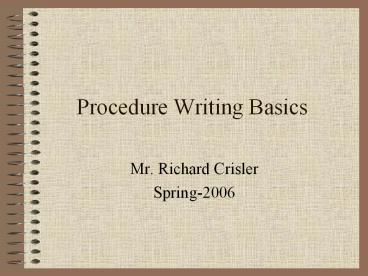Procedure Writing Basics - PowerPoint PPT Presentation
1 / 13
Title:
Procedure Writing Basics
Description:
... System Startup Procedure Normal Operating Procedure Normal System Shutdown Procedure Emergency Shutdown Procedure Waste management Cleanup and checkout ... – PowerPoint PPT presentation
Number of Views:52
Avg rating:3.0/5.0
Title: Procedure Writing Basics
1
Procedure Writing Basics
- Mr. Richard Crisler
- Spring-2006
2
References
- a) Guidelines for Writing Effective Operating
and Maintenance Procedures, Center for Chemical
Process Safety, American Institute of Chemical
Engineers, 1996. - b) ECH 3274L Laboratory Manual, FAMU-FSU College
of Engineering, Dr. Loren B. Schreiber, 2006.
3
Why is it important for you to write effective
procedures?
- ü Helps to reduce accidents protect students
and equipment - ü Promotes safe, efficient operation and
maintenance - ü Helps to ensure that experimental
objectives have been met - ü Helps to improve data quality (accuracy,
precision) - ü Forces students to think about their
experiment in greater detail - ü Helps students understand equipment purpose
and function - ü Helps to prevent gross experimental errors
- ü Promotes the idea that procedures are vital
components of your laboratory experience
4
What are some of the components of an effective
procedure?
- a) Procedures should identify
- Tasks to be performed by each student
- Instrument readings and samples to be taken (how
often, how long, how much?) - Operating conditions to be maintained
- Safety precautions (what are the hazards and what
are the control measures?) - Safe operating limits for critical parameters
(maximum pressures, maximum temperatures) - Critical operating parameters and instruments
- Results of operating beyond safe limits
- Corrective and emergency actions
5
What are some of the components of an effective
procedure?
- Procedures should
- Be complete, to include minor details and
techniques - Be understandable (who is your audience?)
- Use familiar language (accurate terminology)
- Include input from reference materials, teaching
assistants and senior engineer (prepare questions
and take notes!) - Reflect how operations are actually performed
(technique) - Be thoroughly documented
- Be dated and/or have a revision number on every
page - Be updated upon review, and refined while you are
conducting your experiment - Be approved by the senior engineer prior to
starting experimental work
6
What are some of the components of an effective
procedure?
- Users should
- Be informed of all changes
- Be familiar with critical operating procedures
(the team leader may not be present throughout
the experiment)
7
Example-1 (Inadequate Module)
8
Example-1A (Improved Module)
9
Example-1A (continued)
10
Example-1A (continued)
11
What essential elements are present in an
effective experimental procedure?
- Purpose (why was this procedure written)
- References (owners manuals, other procedures,
PFDs, specification sheets) - Safety (PPE required, chemical safety MSDS,
special hazard precautions, information from
previous accidents/incidents) - Required materials (lab ware, tools and
equipment) - Preliminary experimental modules (pump
calibrations, temperature measurements,
calibration curve preparation) - Experimental Objective(s)
- System Startup Procedure
- Normal Operating Procedure
- Normal System Shutdown Procedure
- Emergency Shutdown Procedure
- Waste management
- Cleanup and checkout
12
Stylistic considerations for procedures
- Completeness and accuracy (depends on user
experience and other factors) - Appropriate level of detail (keep it as concise
as possible) - Consistent presentation (maintain the same style
easier to read and understand) - Page layout (open page with limited branching,
unique step numbering) - Caution or warning statements listed before the
appropriate step warns the user of the potential
hazard immediately before the situation occurs. - Use the same numbering scheme throughout the
procedure - Identify notes, warnings and cautions the same
way in all procedures - Use consistent and accurate terminology
13
Questions?































